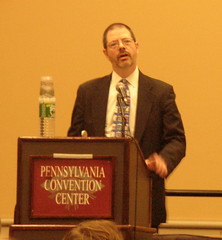I hesitate to intrude — but a vexatious conflict has opened up in an area of Blogaria that’s dear to my interests, and it’s worth deliberating about, in several different dimensions.
The conflict concerns Flickr, “almost certainly the best online photo management and sharing application in the world.” It turns out that at some point, Flickr has begun segregating certain images that do not appear to be photographic, on the basis that their brand identity involves their “photo sharing” function. Drawings, paintings, computer-generated fractal patterns, and doodles do not count as “photos,” on this account, so the 700 Hoboes Project (for one prominent instance) ought not appear in publicly-accessible areas of Flickr. When Flickr has private-ized drawings, their artists and sympathizers have made a ruckus.
To grant Flickr all the sound points possible, it’s clear that they present the site as a photo sharing application, and they do differentiate photos from drawings or other graphic designs. It would be unreasonable to use Flickr as insulation from the bandwidth costs that elaborate graphics can run up. They have made that explicit, although not necessarily obvious. And it’s their (Yahoo’s) site and service, so if they want to enforce their terms of service over against the practice of their clients, then it’s their prerogative.
On the hand, this situations entails certain peculiarities that actually correspond to problems with the RIAA/mp3 controversies. In both cases, commercial agencies try to constrain their clients’ online behavior based on aspects of physical-world media. As a point of fact, there’s no intrinsic difference between jpg files generated by digital cameras and those generated by scanners (EXIL data notwithstanding) — and it’s easy enough to take a digital photo of a drawing, and to scan a photographic print. Which is the true Flickr-OK “photograph”?
Moreover (as constant readers of Jeff Ward or even my talk about visual hermeneutics from two years ago will immediately recall) all these distinctions along the spectrum that runs between “photograph” and “printed text” run the risk of invidious arbitrariness. Is a photograph of printed text more Flickr-OK than a scan of printed text? On what basis? Is a photograph of a drawing more Flickr-OK than a scan of the same drawing? Will it make a difference if a photo has been altered to look more painterly (as with a filter in Photoshop or Painter)? What is it about the bits that have been gathered together to represent visual information in a “photograph” that differentiates them from bits gathered for visual information in a “scanned drawing” or even a digital sketch?
Furthermore, although Flickr has maintained its concentration upon photo sharing, the viral aspects of Flickr have all along been the way they engineered in collaboration and social interaction. Flickr is, after all, the mainstream genius offspring of the eccentric genius of the late lamented Game Neverending (Wikipedia). In both, the most obvious features (photo sharing, multi-player gaming) thrive because they’re wrapped around robust, innovative social software. Under the circumstances, the features that have made Flickr unique and popular have nothing to do with the mechanical means by which bits were defined as representations of an image, and everything to do with the interactions between participants (which again have nothing to do with whether the images involve “photographs” or “drawings” or whatever).
Flickr made itself precious to its clients by devising a way for them to do something they loved. At this point, restricting the bits they can share to “photographic” bits risks cutting down the tree’s trunk in order to sustain its leaves.
All in all, a difficult case, and an odd circumstance in which to read about the Flickr-ization of Yahoo, when one might suspect that current events foreshadow the corporatization of Flickr, instead.
[Later: I should emphasize that, contrary to what some bloggers have written, Flickr neither bans nor removes non-photo images. In the interest of helping users get the search results they want, Flickr excludes non-photo images from searches, and I gather that Flickr is working on ways to enable users to select “photos” or “non-photo illustrations” as a search criterion. At the rate at which Flickr grows, though, engineering a more discriminating search mechanism will take a lot of work. I’m heartened to hear that Flickrites are not out to get illustrators — but I’m not convinced that this is the most productive way to work toward their desired end. On the other hand, I didn’t just build an image-sharing empire and sell it to Flickr for quillions of sheets of purple paper.]

